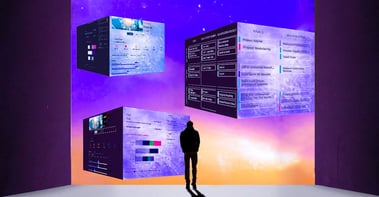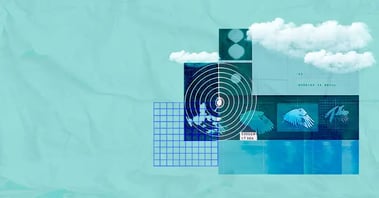The uncomfortable truth: Your innovation process is probably broken in ways you don't see. Most large organizations can point to impressive innovation activities. They run hackathons. They have idea portals. They talk about intrapreneurship. Yet when we ask executives to show how last quarter's market intelligence influenced this quarter's portfolio decisions, we usually get silence.
This isn't an execution problem. It's an integration problem.
Over fifteen years of working with hundreds of innovation leaders, we've seen a pattern: Organizations excel at pieces of innovation but fail to connect them into a functioning system. They're brilliant at foresight but terrible at execution. Or they run tight portfolio processes but feed them with disconnected ideas. Or they generate thousands of ideas that never inform strategy.
The result? Innovation theater. Activity without impact.
This article explains the unique, proven ITONICS innovation methodology. The framework has helped our global customers move from innovation activity to innovation results.
Exhibit 1: The ITONICS innovation methodology
We also call it the Innovation Big Picture (Exhibit 1, download here), and it's built on one principle: Innovation is a continuous conversation between where to play, how to win, and what to execute.
The hidden cost of fragmented innovation
Let me paint a picture you'll recognize:
Your foresight team produces an elegant trends report identifying autonomous logistics as a critical opportunity. It gets presented at the leadership offsite, generates enthusiasm, and then gets filed away.
Three months later, your ideation campaign asks employees for "breakthrough ideas in customer experience." You get 847 submissions. None mentions autonomous logistics. The winning ideas are incremental improvements to existing products.
Meanwhile, your portfolio review approves projects based on business unit advocacy and political capital. The loudest voices win. No one asks whether these projects address the strategic opportunities your foresight identified.
Sound familiar?
You're not lazy. You're not incompetent. You're running three sophisticated processes that don't talk to each other.
The consequence is strategic drift. While your competitors build coherent responses to market shifts, you're allocating resources to disconnected initiatives that happen to bubble up through separate channels.
The ITONICS end-to-end innovation big picture
Here's what works. The ITONICS Innovation Big Picture represents the connected innovation model. It's built on one principle: Innovation is a continuous conversation between strategy, discovery, and execution (Exhibit 2).
Three questions structure this conversation:
- WHERE TO PLAY: What opportunities are attractive to pursue?
- HOW TO WIN: What solutions will create the most value?
- WHAT TO EXECUTE: Which initiatives (and which don't) deserve our finite resources?
Each step matters. But the integration between them is what separates innovation systems that work from innovation activities that don't.
Exhibit 2: The connection between strategy, discovery, and execution
1. Where to Play: Turning uncertainty into strategic clarity
The challenge: In a world of exponential change, yesterday's strategy becomes tomorrow's liability. Yet most organizations only refresh strategy annually, if that.
The solution: Continuous strategic foresight, not episodic planning, informing product strategy when it matters.
The techniques: Continuous environmental scanning, landscape mapping, opportunity space prioritization
Continuous environmental scanning
Your teams systematically monitor emerging technologies, competitor moves, regulatory shifts, startup activity, and weak signals of change. The output are not trend reports, but a continuous, structured intelligence that is always accessible, for everyone.
Think of it as your organizational early warning system. When quantum computing moves from research labs to commercial pilots, you don't learn about it from a consultant. You've been tracking it.
ITONICS developed Prism, an AI companion that helps you discover opportunities ahead of competition (Exhibit 3). Prism auto‑generates industry insights radars in seconds, tracks momentum, and alerts you when it matters, so you can invest early or skip the hype.
/Still%20images/AI%20Mockups%202025/foresight-discover-new-insights-2025.webp?width=2160&height=1350&name=foresight-discover-new-insights-2025.webp)
Exhibit 3: Trend discovery with ITONICS Prism
Landscape mapping
Raw signals get synthesized into actionable insight through structured methods: clustering from signal to trend, impact assessment, and dependency mapping. The goal is compiling a complete overview of the technology push and market pull factors, affecting your business situation - today, next year, the next decade.
Evaluations of impact, time horizon, and domain further refine this complete overview. With ITONICS, you can map this landscape on interactive radars, showing you what needs your attention now (Exhibit 4). It helps ground strategic decisions in evidence and shared beliefs.
/Still%20images/Radar%20Mockups%202025/foresight-keep-everything-on-your-radar.webp?width=2160&height=1350&name=foresight-keep-everything-on-your-radar.webp)
Exhibit 4: ITONICS trend radar
Opportunity space prioritization
This is the output that matters: clearly defined opportunity spaces that answer "where should we play?" These aren't vague aspirations ("be more digital"). They're specific strategic playing fields backed by evidence.
A business opportunity is a situation where unmet customer needs, underserved segments, or emerging shifts in technology, regulation, or behavior create space for new value creation. It is often framed through a qualitative evaluation of a market imperfection (customer dissatisfaction, inefficiency, or untapped potential). It thus offers potential for growth by offering something better, simpler, or more accessible than current offerings.
Example: "Working parents lack flexible childcare options because of rigid provider schedules, but want affordable, short-notice care."
The critical integration point: The opportunity spaces must directly inform your ideation campaigns. When you define strategic priorities or launch an innovation challenge, the strategically validated opportunity space needs to drive this.

Exhibit 5: Opportunity development framework (download here)
Most organizations skip this connection. They do excellent foresight, then run generic ideation ("submit your ideas!"). This is where strategic value gets destroyed.
2. How to Win: Turning opportunities into testable artefacts
The challenge: Having the right strategic opportunities is great. But, only when you build distinctive solutions that are viable, feasible, needed by customers, and you can select and introduce those products before the competition.
The solution: Targeted ideation with clear selection rules that allow fast progression.
The techniques: Challenge-driven campaigns, structured concept selection, evidence-based validation
Challenge-driven campaigns
Launch focused innovation campaigns with clear strategic intent. Not "give us your ideas" but "solve this specific challenge because it will allow us to win this opportunity space."
A well-defined challenge addressing a validated opportunity generates solutions with strategic value. Generic calls for ideas generate noise.
Your challenge brief should answer three questions:
- What opportunity are we addressing? (linked directly to your foresight work)
- What does success look like? (specific, measurable outcomes)
- What constraints matter? (technology, budget, time, regulatory)
Example challenge: "Design a flexible childcare matching system that connects working parents with vetted providers for same-day booking, ensuring safety compliance and price transparency."
ITONICS enables you to launch targeted challenges at scale, from small team sprints to company-wide initiatives. You can configure any workflow, set evaluation criteria, and track submissions against strategic opportunity spaces (Exhibit 6). Run 10 campaigns or 100, each linked to the opportunities that matter.
/Still%20images/Workflow%20Builder%20Mockups%202025/portfolio-use-approval-workflows-2025.webp?width=2160&height=1350&name=portfolio-use-approval-workflows-2025.webp)
Exhibit 6: ITONICS visual workflow configurator
Structured concept development
Good thoughts aren't enough. You need validated concepts with evidence that they'll work.
As submissions come in, guide contributors through increasing levels of detail:
- Initial submission → Core idea articulated
- Enrichment phase → Customer problem defined, solution sketched, value proposition stated
Validation phase → Feasibility assessed, competitive positioning analyzed, business model outlined
Business case → Market sizing, financial projections, resource requirements, risk assessment
Each stage adds evidence. Each stage allows you to filter out concepts that won't survive contact with reality (see Exhibit 7).
Most idea management fails here. Organizations collect ideas, popularity vote, then wonder why "winning ideas" fail in execution. Because voting isn't validation. You need structured development that forces concepts to confront hard questions early.
/Still%20images/Kanban%20Board%20Mockups%202025/ideation-organize-idea-flows-2025.webp?width=2160&height=1350&name=ideation-organize-idea-flows-2025.webp)
Exhibit 7: ITONICS idea boards
Evidence-based validation
Progressive evaluation gates ensure only robust concepts advance:
- Strategic fit screening → Does this address a validated opportunity space? If not, reject regardless of how "innovative" it seems.
- Feasibility assessment → Can we actually build this? Do we have or can we acquire the necessary capabilities?
- Value verification → Will customers pay for this? What evidence supports our value proposition assumptions?
- Resource reality check → What will this actually cost in time, money, and organizational attention?
Each gate is a kill opportunity. That's the point. Better to kill a weak concept after 10 hours of development than a weak project after 10 months of execution.
ITONICS provides configurable evaluation workflows with weighted scoring, multi-stakeholder reviews, and automated progression rules. Define your gates once, apply them consistently across all campaigns.
/Still%20images/List%20Mockups%202025/ideation-evaluate-collaboratively-2025.webp?width=2160&height=1350&name=ideation-evaluate-collaboratively-2025.webp)
Exhibit 8: Concept validation in ITONICS
The critical integration point: Validated concepts must feed directly into portfolio decisions. Not as separate input. As the primary source of portfolio additions.
See how the conversation works?
→ Foresight identifies opportunity spaces
→ Challenges target specific opportunities
→ Structured development produces validated concepts
→ Portfolio review selects which concepts to resource
Break any link in this chain, and strategic value leaks out.
3. What to Execute: Fund per progression, re-scope, or stop
The challenge: You can't do everything. Even well-funded organizations face resource constraints. The question isn't "what could we do?" but "what should we do given our strategic intent and finite capacity?"
The solution: Dynamic portfolio management and integrated roadmapping.
Strategic portfolio balancing
Actively manage your innovation portfolio across multiple dimensions (see a portfolio analysis in Exhibit 9):
- Horizons: Balance quick wins (Horizon 1), adjacent growth (Horizon 2), and transformational bets (Horizon 3)
- Risk: Mix sure things with moonshots
- Resource types: Spread across different capability requirements
- Strategic themes: Ensure coverage of key opportunity spaces identified in foresight
This isn't spreadsheet optimization. It's strategic choice-making with full visibility.

Exhibit 9: Innovation reports in ITONICS
Steer your development with adjustable roadmaps
Roadmaps translate portfolio decisions into coordinated action. They show dependencies, sequence initiatives, allocate resources over time, and communicate strategy across the organization.
Critically, roadmaps aren't static plans filed after annual strategy reviews. They're living documents that update as you learn from execution and as foresight reveals new strategic signals.
Why most roadmaps fail: They become shelfware within weeks of creation. Markets shift, priorities change, resources get reallocated, but the roadmap stays frozen because updating it requires reformatting dozens of PowerPoint slides and rescheduling meetings with seven departments.
What works instead: Dynamic roadmaps (Exhibit 10) that serve as the operational interface for your innovation portfolio. Not documentation of decisions already made, but the workspace where decisions get made and adapted.
/Still%20images/Roadmap%20Mockups%202025/portfolio-visualize-critical-paths-2025.webp?width=2160&height=1350&name=portfolio-visualize-critical-paths-2025.webp)
Exhibit 10: Roadmaps inside ITONICS
The critical integration point: Portfolio decisions must be explicitly tied to strategic opportunity spaces from foresight. When you approve a project, you're making a bet on a specific opportunity. When you kill a project, you're either learning that the opportunity isn't viable or that this approach won't win.
Track this explicitly. Don't let portfolio decisions drift from strategy because powerful executives advocate for pet projects.
The hard part isn't understanding this, it's doing it
Most innovation leaders we meet nod along to this framework. "Yes, that's how it should work."
Then we ask: "Show me in your systems. Show me how a trend identified last month shaped the ideation challenge you just launched. Show me the portfolio decision that explicitly rejected a project because it didn't address a strategic opportunity space."
Usually, they can't. Escape this trap and treat innovation as a strategic asset. ITONICS is the best innovation management software to run a successful innovation process. Our innovation platform embodies all the essentials of the best innovation management software and covers all the application areas in one tool. With ITONICS, you can:
Eliminate information silos: ITONICS centralizes all your innovation projects, ideas, and teams in one place. Reduce duplicated efforts, dispersed teams, and disconnected data.
Track actionable KPIs: ITONICS allows companies to define and track KPIs that align with their strategic ambitions. This ensures that innovation projects deliver value and contribute to business success.
Generate customized reports: Create tailored innovation reports and dashboards that meet the specific needs of various stakeholders. Whether you need a high-level business summary or a detailed project breakdown, ITONICS makes it easy to generate the right reports.



-graphs-to-convince-management.jpg??&width=379&height=288&name=Header-The-10-(X)-graphs-to-convince-management.jpg)

